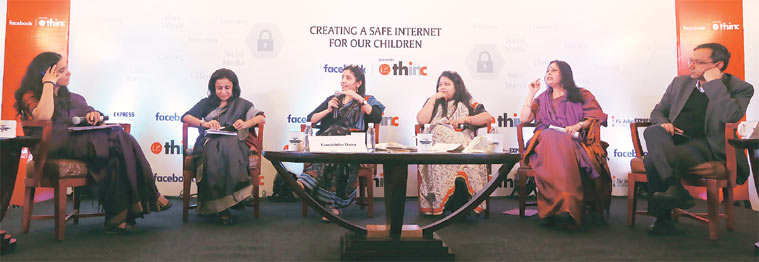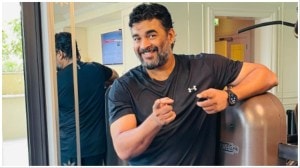- India
- International
At Express Thinc: ‘Prepare the child to become the Netizen of tomorrow’
At the fourth edition of The Indian Express Thinc in association with Facebook, panellists discussed the need for ‘Creating a safe Internet for our children’ so that they can use it as a tool responsibly, while learning to avoid the risks involved. Excerpts from the discussion.
 From left: The Indian Express Associate Editor Uma Vishnu moderates the session with UNICEF India child protection specialist Tannistha Datta, child & adolescent psychologist, family therapist and Children First co-founder Dr Shelja Sen,McAfee’s Cybermum in India Anindita Mishra, Springdales School (Pusa Road, New Delhi) principal Ameeta Mulla Wattal, and Delhi Police cyber cell DCP Anyesh Roy at Claridges Hotel in New Delhi. (Photo: Prem Nath Pandey)
From left: The Indian Express Associate Editor Uma Vishnu moderates the session with UNICEF India child protection specialist Tannistha Datta, child & adolescent psychologist, family therapist and Children First co-founder Dr Shelja Sen,McAfee’s Cybermum in India Anindita Mishra, Springdales School (Pusa Road, New Delhi) principal Ameeta Mulla Wattal, and Delhi Police cyber cell DCP Anyesh Roy at Claridges Hotel in New Delhi. (Photo: Prem Nath Pandey)
The Internet offers endless possibilities for children but, considering the time they spend online, it is also imperative to ensure it is safe for them. How can parents and educators help children leverage this tool while steering them away from the pitfalls? Earlier this month, The Indian Express, in association with Facebook, organised a panel discussion where Ameeta Mulla Wattal, principal, Springdales School, Pusa Road, New Delhi; Dr Shelja Sen, child and adolescent psychologist and family therapist, co-founder of Children First, an institute for child & adolescent mental health in Delhi; Anyesh Roy, DCP, Cyber Cell, Delhi Police; Tannistha Datta, child protection specialist, UNICEF India; and Anindita Mishra, McAfee’s Cybermum in India; addressed these challenges while coming up with prescriptions for a safer Internet. This session of IE Thinc was moderated by Associate Editor Uma Vishnu.
Uma Vishnu: Dr Sen, can you draw on your experiences as a psychotherapist to help us understand I-Gen, this generation that has grown up on Internet and social media, from the nature of their social media experiences and the state of their mental well-being?
Shelja Sen: One thing I would like to clarify is: we keep talking about how young people are addicted to the Internet and social media… I think equally we’re addicted to it. It’s affecting everybody, but children are most vulnerable, and some children are more vulnerable than others. But Internet, social media can be used for connectivity, learning, entertainment. The change has happened so fast that we are waking up to the impact it is having on our children. Neuro-developmentally, children are growing, their brain circuits are forming, and children are learning how to pay attention. And when they have a laptop or a computer next to them, it is very difficult for them to concentrate. A lot of research is being done… the brains are changing; emotionally it is impacting them… I asked my daughter, suppose all social media, Internet, everything was to go away, for everybody. She’s 16 and she said, “That would be cool.” So kids want to be on it because everybody wants to be on it. Socially it is impacting them… A young person going through depression might turn to social media to numb that pain. And there the person is seeing other people doing much more fascinating things than the person is doing, and that exacerbates and sets the cycle… Young people who are more depressed will get sucked into Internet much more.
Uma Vishnu: So how do parents work out a way?
Anindita Mishra: Cyber bullying is a problem that becomes manifold in the case of a child. The bully is leveraging three aspects — the child’s naivety, need for peer approval, lack of self-esteem. ‘Likes’ will determine whether I am feeling good or bad; therein comes the need for approval, therein comes ready material for bullying. Not just social media, you can be bullied on your gaming devices also… My advice to parents is not to get overly concerned or threatened. Prepare the child to become the Netizen of tomorrow. There are three steps. Use the right digital technologies with a parenting control feature that allows you to flag unauthorised usage, monitor access, even block websites. Please do it in the knowledge of the child. This is the second point: parent-child communication is important. The child should always be ready to come to you and confide in you… Third, upgrade the education [system] so that cyber bullying becomes part of social studies… and how to tackle it.

Uma Vishnu: When bullying is anonymous, what do you tell parents?
Anyesh Roy: Bullying is not a cognisable offence unless there is an element of sexual harassment or physical harm… Cyber bullying, per se, does not require police intervention. But we have been creating awareness. We conduct workshops for school computer teachers, tell them they can act as force multipliers and enable the child to report online abuse. Our intervention is more on the lines of counselling parents. The second aspect is anonymity. Normally, we have found that children are not using anonymous tools. Whenever we have a case, we zero in on the person concerned.
What’s the nature of cybercrimes in India beyond cyber bullying?
Tannistha Datta: Let me also weigh in a little bit on cyber bullying. Data shows more than half the people bullying the other half are children themselves. A parliamentary committee on technology in 2014 left it out of any new law as you don’t want to victimise children against each other. About other forms of cybercrime, in 2016 we did a comprehensive assessment of what is the life of a child in the online space. We came up with a whole typology of risks or crimes or offences which children could face in the online space. The report, ‘Child Online Protection in India’, is available online. Cyber bullying is the largest category of risk but there’s also online sexual exploitation, cyber radicalisation, online fraud and identity theft, habit formation and enticement [to] online gambling. And also grooming, the process sexual predators take online to approach a child, become friends and gradually it may go on to sexual harassment. We see the line between online and offline abuse blurring and this is a concern. These are complex issues in which the role of law enforcement becomes critical.
Uma Vishnu: What are the cases you have come across as principal?
Ameeta Mulla Wattal: The millennials love the Internet and multi-tasking. They are remarkable young people and their brains are fabulously wired. They have a constant requirement of instant gratification, connected with the need for independence and autonomy, both of which they get via the Internet. That creates the worry as you open out your windows to anyone as you want to feel relevant. This is what we need to look at: because of consistency on the Internet, decision-making skills are losing out and concentration spans dwindling, affecting learning. So we need to look at technology as a tool and not as something taking over our lives. With regard to bullying, I have seen it as a rural-urban divide. In rural areas it is at a nascent stage and not an epidemic. In metros, cities, there’s a divide amongst families where both parents are working and children come to an empty home; and it’s a divide between children who live in joint families where they have conversations with people if they are worried. We see this in classrooms. We have created cyber peace messengers who are counsellors who ensure that children can come and tell them if something is happening. Also, through certain collaborative children, we find out who is being bullied, and immediately the person is called. This we call bully security. We invite mentors and peer-to-peer help where children come and say I think we must must look into a child’s Facebook… Bullying takes two or three forms. One is if a child feels I should be made the prefect, I was not. Or another person is more attractive than me, how do you cope with that? Or if a girl wants to ward off a boy and he can’t cope with it, he bullies… There is also a gender divide. I discovered girls are both victims and perpetrators of bullying. [When] girls cannot cope with the body beautiful culture, they become objects of bullying.
Anindita Mishra: Body shaming is also a kind of cyber bullying. Therefore that A4 Challenge came up, prior to Blue Whale Challenge, which is basically the need for people to be better than the rest. This is the need for peer approval, because they are not getting sufficient approval at home
Tannistha Datta: To come in on the gender divide, the UNICEF report on ‘Children in the Digital World’ looked closely on opportunities the digital world is providing and how is it creating inequities between them. The world over, a lot of children are not accessing the Internet, either because they are in rural areas, or because they are women. It is important to understand if digital access is the way to go, if it has opportunities for all children.
 From the audience, a question for the panellists. (Photo: Prem Nath Pandey)
From the audience, a question for the panellists. (Photo: Prem Nath Pandey)
Uma Vishnu: So there can be no longer such a thing as passive parenting?
Shelja Sen: We must find where the responsibility lies. Parents? Schools? Responsibility lies with social media itself. We cannot put blame just the parents; media, social media, parents, schools all must take responsibility. Bill Gates, Steve Jobs were responsible enough to not give gadgets to their children when they were small. There has to be an adult alliance where we need to do what must be done. If adults say this is how things are going to be, children will agree. I agree communication at home must be there with children. Facebook is passe now; Snapchat, Instagram, YouTube are where children are; we need to be aware what is happening on these platforms. Parents have to talk and set boundaries and communicate. Also mindfulness… I have to be more mindful of gadgets I use at home.
Ameeta Mulla Wattal: Parents are scared of their children, scared as to what they might do. Children can use this emotionally. Parents are held hostage to give a phone. Today it’s a dangerous world, even in metros. We need to work between crevices to look at child rearing and a lot of hand-holding is needed.
Tannistha Datta: I urge you not to forget that the urban-rural divide is not so much about access anymore. It’s about access to safety. For example, say a girl in Mirzapur whose brother works somewhere in Mumbai as a labourer… He has bought her a cheap Chinese phone. She is a first-generation learner and cannot have these conversations with her parents as they are probably farmers. It’s important to support these kids who have no access to resources on how to keep themselves safe. Those children are far more vulnerable. Here role of social media, to have regional language communication of safety, that’s really a focus.
Anindita Mishra: I would like to say the cybercrime police are doing a good job as they are tweeting a lot of cyber-safety messages. I found as people believe in police, they retweet them. [But] on Internet, private videos are being shared. Why should I be sharing a young girl dancing when I don’t know them? Sharing must not be without permission. That is a value I must have. It has to start at home, to spread value education. Children need to be trained to think long-term.
Ameeta Mulla Wattal: Children look at WhatsApp group conversations among young mums and get affected too. Some of these groups can be bad with regard to language. Children may not listen to what you say, but they do what you do.
Uma Vishnu: How do police reach out on social media?
Anyesh Roy: Some of our tweets and posts are based on our experience on how you deal with complaints, some are inspired from the Internet. But we try to keep it relevant and direct. We have an agency to add glamour to it. We have print media advertisements also on cyber safety aspects. Our special police unit for women and children, Go to School, has covered more than two lakh students on cyber-security threats and what to do against it, steps to be taken. We at the Cyber Crime Cell of Delhi Police take pains to engage students via the school system.
Uma Vishnu: Technology grows so fast, how do police get help to keep up?
Anyesh Roy: In India, we are at the forefront of it, as there is no other police organisation with a set-up that can be emulated. Two years back, we laid out a three-tier structure, starting with the police station where we have a cyber team headed by an inspector-level officer, at district level we have district cyber cells, and at headquarters level there is a central cybercrime cell. There are special cyber cells dealing with specialised areas such as anti-terrorist activities, organised crime etc. We started monthly awareness campaigns, we decided to train our officers in-house, we have trained 1,100 of our officers, and if they can’t be settled at police-station level, it gets escalated to central agencies. Basic training involves knowing the IP address associated with the complaint and then conventional work that begins, be it seizing the mobile or laptop, what has to be done for that purpose etc. A minimum of five trained personnel are there in Delhi police stations who can handle a cybercrime. We are getting funds from Ministry of Home Affairs to equip our district cyber cells with forensic equipment and hopefully in one year, 14 districts will have them to do preliminary investigation.
Tannistha Datta: Skills of police to handle cybercrime at other places [outside Delhi] are really not that great. Even in handling of evidence, basic rules don’t get met, and when a case goes to the prosecution stage, the defence will just throw it all out. Skills of police to handle cyber investigation must be updated, and must happen at state levels.
Anyesh Roy: We have a website dedicated to cyber safety. We have components of child and women safety. We have an online reporting system. We found that when a complaint comes to us and we begin investigation and the complainant is asked to give a screenshot of things bothering him, he goes to see that it no longer exists. So we give basic simple things of dos & don’ts and what needs to be done. Such information can be provided by all other police stations.
***
Audience question: In India we do not have an online security culture for children. The state is missing out here; it misses out on issues of cyber bullying etc with regard to children’s rights. Where is state policy towards it?
Anyesh Roy: In the absence of supportive legislative provisions, police have taken some proactive measures.
Tannistha Datta: The National Plan of Action for Children has a section on online safety. There is a lot of thrust from the Women & Child Development Ministry. A lot of requests have come to UNICEF to plug the evidence gap, to do researches; global researches to look at children’s online habits, to support them for programmes of protection. The National Commission for Protection of Child Rights has started an ePOCSO button. Mr Roy was talking about online reporting; we have come out with a lot of materials on what can be done by different stakeholders. I don’t think there is no awareness of what needs to be done, nor of intent. I think what probably needs to be done is inter-ministerial coordination mechanism that can give a lot of weight to it. For example, the Ministry of Home is taking on cyber safety, Ministry of Women & Child Development is looking at children’s safety issues, Ministry of HRD is looking at how schools can integrate these in the curriculum. What is lacking is a formal way in which one can speak to the other and have regular convergence and coordination. So it’s a matter of time for us to see the policy thrust.
Audience question: The American Academy of Paediatrics keeps reviewing its work, which is then sent out to paediatricians across the country. Do we have anything like this in India?
Shelja Sen: As yet, India does not have this. I tell parents that till age two there be no screen exposure to children. By age four they could be exposed to nursery rhymes etc in minimal fashion, and till age 13, 14 it should be very regulated, in a conversational way. By 15, 17, it is impossible to regulate, and you can depend on your relationship with the child.
Paresh Shah (technical expert, National Commission for Protection of Child Rights): An expert group was formed and a comprehensive manual was formed, inter-ministerial convergence meet was there. The manual is on the website. Discussion is still on at ministry level. A lot of traction is happening.
Vithika Rahul (HoD-psychology, DPS-R K Puram): We come across cases where there is sexual content, but there is no fear. Children don’t fear it. Can we use the fear factor to guide them?
Anyesh Roy: Depending on the gravity of things, we can counsel the juvenile and action cannot be taken against them. For certain category of offences, let’s say beyond age 15, action can be taken. A person sharing content must also be accounted for. We have to be restrained with juveniles, we may consult their parents rather than have consequences for the child. But the basis of the Juvenile Justice Act says delinquents are also victims themselves.
Anindita Mishra: Digital footprints will stay there forever; that must be conveyed to the child.
Ameeta Mulla Wattal: Bring in processes of gender sensitivity and sex education into schoolrooms. Understand what is responsible sex, one must respect the other and not blaspheme others on the Internet.
Shelja Sen: I agree it’s about making the child understand the consequences, and about the process of gender sensitivity.
Laksh Vir Sehgal (Principal, Bal Bharati Public School, GRH Marg, Delhi): How is creativity being affected as children go straight to the Internet without thinking much about problem-solving? Secondly, there is false information on Internet.
Shelja Sen: We are making children a passive people but it is we who have created these problems. The way they think is different, they have a creative way of living and not mere reactionists.
Anindita Mishra: We need to teach children about the sources they get their matter from and not plagiarise. Also wrong facts are there and we need to teach children if they are giving right facts before they share.
Ameeta Mulla Wattal: Yes, a lot of homework is cut/paste. Twentyfirst-century revolutions have been started by young people. They have tremendous ideas on even political thought. Do they understand correct data, sift the data and know how to analyse data and then create what they are creating?
Uma Vishnu: Can we have, from each of the panellists, one tip for the parents, one tip for the child?
Tannishta Datta: No tips for children, let them be for parents. They should not be judgmental of what their children are doing on the Internet. Listen to children.
Shelja Sen: Build a community, it takes a village to raise a child. When a sense of community is missing, then the online world becomes the only life.
Anindita Mishra: Like Rajinikanth would say, mind it, whatever you are doing online.
Ameeta Mulla Wattal: We should look at intimacy. Let us know our children.
Anyesh Roy: For children, there are real-world consequence to everything you do online. And that the audience is much more than you targeted; online content stays on it forever. For parents, tell your children that they are seeing a part of others’ lives and they do not do it all the time.
More Tech
Apr 25: Latest News
- 01
- 02
- 03
- 04
- 05































